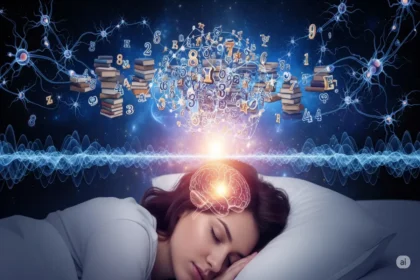The human mind, even in its deepest slumber, remains a theatre of endless possibilities. We drift through landscapes of the absurd, the beautiful, and the terrifying, often waking with a lingering sense that our nocturnal narratives hold a deeper meaning. Among the most captivating and enduring beliefs about dreams is the idea that they can peer beyond the veil of the present, offering glimpses of what is yet to come. The question of whether our dreams predicting the future is a notion that has fascinated humanity for millennia, weaving its way through ancient prophecies, folklore, and personal anecdotes. But what does science have to say about these seemingly prescient experiences? Can our sleeping minds truly foretell events, or is there a more grounded, yet equally remarkable, explanation for those uncanny moments when a dream seems to manifest in waking life?
From the oracles of ancient Greece interpreting dream visions to the biblical accounts of Joseph’s prophetic dreams, the idea of premonitions in sleep is deeply embedded in our collective consciousness. Throughout history, countless individuals have reported dreams that appeared to foreshadow real-world events, from minor coincidences to major catastrophes. Think of Abraham Lincoln, who reportedly dreamed of his own assassination just days before it occurred, or Mark Twain, who claimed to have dreamed of his brother’s death years before it happened. These compelling anecdotes, passed down through generations, fuel our curiosity and reinforce the allure of the premonitory dream.
However, while such stories are undeniably captivating, scientific inquiry demands a different lens. Anecdotal evidence, by its very nature, is difficult to verify and often subject to the powerful influence of human perception and memory. To truly understand if dreams can predict the future, we must delve into the intricate workings of the brain during sleep and explore the psychological phenomena that might give rise to these seemingly prophetic experiences.
The Brain’s Nightly Synthesis: Memory, Patterns, and Subliminal Cues
Our dreams are not random neurological static; they are complex, dynamic productions orchestrated by the brain, primarily during Rapid Eye Movement (REM) sleep. During this paradoxical state, the brain is highly active, consolidating memories, processing emotions, and making connections between disparate pieces of information. It is this incredible capacity for synthesis and pattern recognition that offers a compelling scientific explanation for why some dreams might feel like premonitions.
Consider the brain as a sophisticated supercomputer, constantly taking in vast amounts of data from our waking lives – sights, sounds, conversations, emotions, and even subtle, subliminal cues that our conscious mind might overlook. During sleep, particularly REM, the brain’s “night shift” begins. It sifts through this immense dataset, organizing, filing, and strengthening memories. This process isn’t always linear or logical; the dreaming brain is free from the constraints of waking reality, allowing it to make novel, associative connections between seemingly unrelated pieces of information.
For instance, you might subconsciously notice a colleague’s unusual stress levels, a subtle change in their demeanor, or a fleeting comment they made about a difficult project. Your conscious mind might not register these as significant. However, during sleep, your brain synthesizes these fragmented observations, recognizing a pattern of impending trouble. This could then manifest in a dream about that colleague making a mistake or facing a crisis. When that event subsequently occurs in waking life, it feels like a prediction, but in reality, it was your subconscious mind processing and extrapolating from already available, albeit subtle, information. It’s not foretelling the future; it’s making an incredibly informed, albeit unconscious, deduction.
Confirmation Bias and Selective Recall: The Mind’s Filters
One of the most powerful psychological phenomena contributing to the belief in premonitory dreams is confirmation bias. This is our inherent tendency to seek out, interpret, favor, and recall information in a way that confirms our existing beliefs. If we believe that dreams can predict the future, we are far more likely to remember and highlight those instances where a dream seemed to “come true,” while conveniently forgetting the countless other dreams that bore no resemblance to future events.
Imagine you have five dreams in a single night. One is about a flying elephant, another about a mundane grocery trip, a third about a bizarre conversation with a historical figure, a fourth about a minor work mishap, and a fifth about winning the lottery. The next day, your colleague spills coffee on their shirt, a minor work mishap. Suddenly, the dream about the work mishap stands out. You might think, “Aha! My dream predicted this!” Meanwhile, the dreams about the flying elephant, the historical figure, and the lottery win are quickly forgotten or dismissed as random. This selective recall creates a powerful illusion of prescience. We remember the “hits” and forget the “misses,” reinforcing our initial belief.
Furthermore, dreams are often vague, symbolic, and open to multiple interpretations. A dream about “losing something valuable” could be interpreted as predicting a lost wallet, a broken relationship, or a missed opportunity. When one of these events inevitably occurs, the dream can be retroactively fitted to the outcome, making it seem predictive. This flexibility in interpretation allows for a wide range of “hits” that can be attributed to a single dream.
The Power of Probability and Coincidence
Let’s consider the sheer numbers. An average person has multiple dreams every night, and over a lifetime, this amounts to tens of thousands, if not hundreds of thousands, of distinct dream experiences. Simultaneously, countless events, both significant and mundane, unfold in the world around us every day. Given this vast number of dreams and an equally vast number of real-world occurrences, it is statistically inevitable that some dreams will, purely by chance, coincide with future events.
If you dream every night, and each dream contains numerous elements, characters, and scenarios, the probability of one of these elements aligning with a real-life event, even a seemingly specific one, increases dramatically over time. It’s akin to the “infinite monkey theorem” – given enough time, a monkey randomly typing on a keyboard would eventually produce the complete works of Shakespeare. Similarly, given enough dreams, some will, by pure coincidence, appear to be prophetic. Our brains, wired to find patterns and meaning, then latch onto these coincidences, elevating them to the status of premonitions.
Subconscious Observation and Anticipation
Perhaps the most scientifically robust explanation for seemingly premonitory dreams lies in the brain’s extraordinary ability to process information at a subconscious level. Our minds are constantly absorbing cues from our environment, our interactions, and our own internal states, far beyond what our conscious awareness can grasp.
For example, a person might be unconsciously aware of subtle tensions in a relationship, the declining health of a loved one, or the precarious financial situation of their company. Their conscious mind might suppress this information or not fully acknowledge it. However, the subconscious mind, unburdened by the need for logical coherence, can synthesize these subtle observations into a dream narrative that reflects an impending outcome. When that outcome materializes, it feels like a prediction, but it’s actually the result of sophisticated, subliminal data processing.
Consider the case of a pilot who dreams of a plane crash before a real-life incident. While seemingly prophetic, it’s possible that the pilot’s subconscious mind had already registered subtle mechanical anomalies, unusual weather patterns, or even a feeling of unease from the ground crew that their conscious mind had dismissed. The dream then served as a warning, a synthesis of these subliminal cues, rather than a supernatural premonition. The brain, in its resting state, is simply better at connecting these dots without the interference of waking distractions or rational filters.
The True Power of Dreams: Beyond Prediction
While the scientific evidence does not support the notion of dreams literally predicting the future, this does not diminish their profound importance. Dreams are incredibly powerful tools for:
- Emotional Processing: They allow us to process and regulate complex emotions, helping us cope with stress, trauma, and anxiety in a safe, simulated environment.
- Memory Consolidation: They play a vital role in strengthening and integrating memories, transforming fleeting experiences into lasting knowledge.
- Problem-Solving and Creativity: By making novel connections and suspending logical constraints, dreams can offer fresh perspectives, spark creativity, and even help us arrive at solutions to waking problems.
- Self-Reflection: Dreams provide a unique window into our subconscious concerns, desires, and fears, offering insights into our inner world and prompting self-awareness.
The human fascination with premonitory dreams speaks to our innate desire to understand the unknown and to find meaning in the seemingly random. While the scientific lens shifts our understanding from supernatural foresight to sophisticated neural processing, the wonder of the dreaming mind remains undiminished. Our dreams may not foretell the future, but they certainly reflect our present, process our past, and prepare us for what lies ahead, equipping us with emotional resilience, cognitive clarity, and a deeper understanding of ourselves. So, the next time a dream feels eerily predictive, instead of seeking a supernatural explanation, perhaps pause to marvel at the extraordinary capabilities of your own subconscious mind – a silent, tireless observer and synthesizer, working diligently to help you navigate the complexities of your waking life.
Disclaimer: The information provided in this article is for general informational purposes only and does not constitute medical advice. It is not a substitute for professional medical advice, diagnosis, or treatment. Always seek the advice of your physician or other qualified health provider with any questions you may have regarding a medical condition. Never disregard professional medical advice or delay in seeking it because of something you have read on this website.













